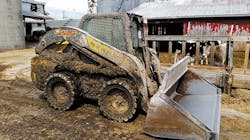Solid Growth: Equipment Operators Move Away From Foam-Filled Tires
More people are choosing solid industrial tires for forklifts, skid steers and even farm equipment, according to manufacturers. They cite a variety of reasons, beginning with affordability.
“On average, a solid tire contains three times the amount of tread rubber compared to a pneumatic of the same size,” says Darren Stratton, product manager for material handling at Camso Inc. “Although the cost of acquisition is higher, the cost of ownership over the life of the tire represents a significant saving.”
Solid tires also improve safety as there is no need to monitor air pressure, which affects both tire wear and the stability of a lift truck, according to Stratton.
“Once you start adding up the cost of ownership, reduced downtime and maintenance, and added safety, the benefits are clear and this is something most fleet operators know very well.”
Used in more places
Christopher Durbin, manager-OE at Balkrishna Industries Ltd. (BKT), says solid tires are gaining use in the scrap yard, glass recycling, wood product manufacturing, mining and materials handling industries. The ability of solid tires to resist punctures, cuts and snags, which limits machine down time due to repairs, is just one of many reasons for their growing use.“Solid tires are also designed for longer service life under extreme conditions. End users have found that down time equates to a loss in productivity.”
Durban says solid tires can have physical characteristics needed for specific reasons, such as non-marking and resistant to corrosive chemicals. In addition, solid tires can be made smooth or designed for traction. “Different compounds are used in making the body/fill of the tire so that ride comfort can be built in as well.”
Solid tires are growing at the expense of foam-filled pneumatics, according to Brad Feeney, director of commercial tire programs at TBC Brands LLC.
“The construction market has grown for the last few years so it would be true to say that both solid and pneumatic tires are growing with the overall market. There is a need for solid industrial tires as they represent a large percentage of the material handling forklift fitments. There has been growth in the market as solids are taking market share from foam-filled pneumatic as they become more affordable and are easier on ride conditions.”
Operators of ground support equipment at airports have switched to solid tires, according to Vance. In addition, there is a new demand for solid tires in the skid steer application.
“Specialty operations such as waste transfer facilities, construction sites and other operations with severe underfoot conditions are using solid tires for their advantages. Most companies cannot afford downtime. As long as the floor conditions are good and speed is kept below 10 mph, there are many advantages to solid tires.”
In addition to being puncture-proof, solid tires eliminate the need to maintain proper air pressure. Other advantages are high load capacity and increased wear resistance.A favorite on skid steers
The solid industrial tire segment is growing far beyond the old, smooth press-on warehouse solids, according to Seth Walters, manager of special project programs at Alliance Tire Americas Inc.
“As the construction industry continues to rebound, we’re seeing a lot of interest in solid skid steer tires that are designed for traction and built to handle broken pavement, rocks, rubble, and scrubbing on paved surfaces,” he says.
“There’s also swiftly growing demand for solid tires from the waste handling industry as well as the growing recycling industry. Scrap metal yards and steel mills are the ultimate ‘severe service’ environment where solid tires are a must, and even landscaping contractors see the benefits of solids for equipment that works with excavation, rock and pavement.”
Solid tires bring an opportunity for cost savings to construction sites. Their durability helps reduce damage to tires by inexperienced machine operators, according to Walters.
“New workers on a job site can be tough on machinery and on tires, resulting in punctures and sidewall incursions,” says Walters. “Solid tires are not only great for minimizing downtime and running machinery longer on a set of tires. They can also be a very effective safeguard against unnecessary tire repair and replacement costs.”
Walters also sees more interest in solid tires from farmers, especially on dairies and hog operations, where skid steers are used daily in paved yards and concrete alleys.
“Banging up against concrete alley curbs can damage tires, and the constant wear of turning in tight spaces while managing feed and manure can reduce the life of ordinary skid steer tires.”
A tread pattern revolution
The real revolution in solid tires is bringing proven tread patterns from pneumatic tires into solid construction, according to Walters. “As more industries start to see the value of solid tires in reducing downtime and increasing productivity in a wide range of severe service environments, it becomes more important to build tires specifically to excel in those environments.”TBC’s Feeney says tread patterns also contribute to ride comfort. “Tread patterns are a part of solid tire solutions. They can provide improved traction, decrease heat buildup and help with ride comfort as operator fatigue is a major concern for material handling companies.”
At Camso, the intensity of the application is the primary concern to ensure the tire is capable of the job, according to Stratton. The company recently introduced a usage intensity calculator designed to help find the appropriate tire by taking into account factors such as lift capacity, working environment, idle, travel and maneuvering time.
But tread patterns have a role in maximizing the payback on a solid tire investment. “When a customer has specific requirements, such as energy savings or vibration, we may recommend a product with a tread pattern that optimizes those parameters,” says Stratton. “With that said, the tread pattern has to work in concert with a rubber compound that also delivers the same benefits.” ■
About the Author

Ann Neal
Ann Neal is a former senior editor at Modern Tire Dealer.
